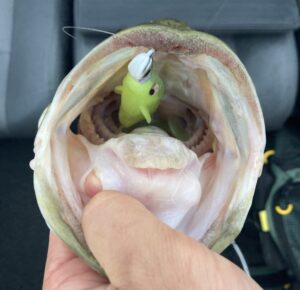 Welcome to Angling Currents, a series of reports keying in on productive fishing patterns and techniques working right now, as explained by some of the best anglers in the nation. These short features are conceived and shared to help both beginning and experienced anglers find more success on the water.
Welcome to Angling Currents, a series of reports keying in on productive fishing patterns and techniques working right now, as explained by some of the best anglers in the nation. These short features are conceived and shared to help both beginning and experienced anglers find more success on the water.
Two primary factors combine to make late-summer largemouth bass challenging to catch in many water bodies. First is that they’re often widely dispersed because they’re keying in on different forage. Bass can be suspended over deep water targeting schools of suspended baitfish; in dense, shallow, oxygen-rich weeds making a living on bluegills, shiners and frogs; or found relating to offshore structure like humps, points, and ledges, often at or near the depth where the thermocline intersects the structure. Second is that bass have been pressured all summer long. Success in late-summer bass fishing often means finding more active fish that are willing to play. That requires focusing your efforts on areas with the highest concentrations of bass and showing your bait to as many as possible.
THICK VEGETATION FISHING
By late August, weeds may either be submerged or top out on the surface. Find dense, healthy, green vegetation and you’ll likely find concentrations of bass. These areas have abundant oxygen and shade, which are good for both bass and baitfish. Three-time Junior Division National Champion, Trey McKinney of Goresville, Illinois advises starting your shallow bass hunt by working a topwater frog in the thickest green stuff you can find.
 Bass can be really pressured by late August, but there’s still a lot of fish shallow – even big ones. Frogs come over and through thick vegetation cleanly and allow you to cover water quickly while searching for active fish,” McKinney says. Key locations include anywhere vegetation exists near current, or where two different types of vegetation merge. “Look for long run out points with grass mats or even in the backs of creeks,” advises McKinney, who also likes to fish frogs through thick duckweed mats that form in slackwater pockets and coves.
Bass can be really pressured by late August, but there’s still a lot of fish shallow – even big ones. Frogs come over and through thick vegetation cleanly and allow you to cover water quickly while searching for active fish,” McKinney says. Key locations include anywhere vegetation exists near current, or where two different types of vegetation merge. “Look for long run out points with grass mats or even in the backs of creeks,” advises McKinney, who also likes to fish frogs through thick duckweed mats that form in slackwater pockets and coves.
“I start fishing frogs once water temps hit about 55 degrees in the spring – in current, on grass, wood, even rocks – but they really come into their own in August and September.” McKinney most often uses a Scum Frog Launch Frog tied to 65-pound braid. His preferred frog rod is a St. Croix BassX 7’4” heavy power, fast action casting rod. “It’s got enought length and just enough tip that you can throw it a mile. Long casts are key when covering water, and when bass hit, the length helps pick up line and stick them fast. St. Croix has that same rod in its Mojo Bass Series as well, along with a 70HF and a 710HF, which make great frog rods, too.”
McKinney keeps two rods rigged when frogging, one with a fast 8.3:1 reel for bomb casting and searching, and one with a more powerful 6.3:1 reel once he’s on them. “I like the faster reel because it allows me to cover more water, but you do lose some cranking power. The powerful 74HF BassX rod with a 6.3:1 reel is an ideal.
By Josh Lantz

